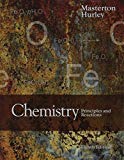
(a)
Interpretation:
The given table needs to be completed with respect to pressure, volume, temperature, number of moles and mass of dinitrogen tetroxide gas.
Concept introduction:
The
Here P is the pressure of the system, V is the volume, n is the number of moles, R is the universal gas constant and T is the temperature.
Mole is a ratio between mass and molar mass. It can be calculated as follows:
Here, m is mass and M is molar mass.
(b)
Interpretation:
The given table needs to be completed with respect to pressure, volume, temperature, number of moles and mass of dinitrogen tetroxide gas.
Concept introduction:
The ideal
Here P is the pressure of the system, V is the volume, n is the number of moles, R is the universal gas constant and T is the temperature.
Mole is a ratio between mass and molar mass. It can be calculated as follows:
Here, m is mass and M is molar mass.
(c)
Interpretation:
The given table needs to be completed with respect to pressure, volume, temperature, number of moles and mass of dinitrogen tetroxide gas.
Concept introduction:
The ideal gas law states the relationship between the pressure, volume, number of moles and temperature of gas at ideal conditions and it is calculated using the following formula:
Here P is the pressure of the system, V is the volume, n is the number of moles, R is the universal gas constant and T is the temperature.
Mole is a ratio between mass and molar mass. It can be calculated as follows:
Here, m is mass and M is molar mass.
(d)
Interpretation:
The given table needs to be completed with respect to pressure, volume, temperature, number of moles and mass of dinitrogen tetroxide gas.
Concept introduction:
The ideal gas law states the relationship between the pressure, volume, number of moles and temperature of gas at ideal conditions and it is calculated using the following formula:
Here P is the pressure of the system, V is the volume, n is the number of moles, R is the universal gas constant and T is the temperature.
Mole is a ratio between mass and molar mass. It can be calculated as follows:
Here, m is mass and M is molar mass.
Trending nowThis is a popular solution!

Chapter 5 Solutions
Bundle: Chemistry: Principles and Reactions, 8th, Loose-Leaf + OWLv2, 1 term (6 months) Printed Access Card
- Please help me solve this reaction.arrow_forwardIndicate the products obtained by mixing 2,2-dimethylpropanal with acetaldehyde and sodium ethoxide in ethanol.arrow_forwardSynthesize 2-Ethyl-3-methyloxirane from dimethyl(propyl)sulfonium iodide using the necessary organic or inorganic reagents. Draw the structures of the compounds.arrow_forward
- Synthesize 2-Hydroxy-2-phenylacetonitrile from phenylmethanol using the necessary organic or inorganic reagents. Draw the structures of the compounds.arrow_forwardSynthesize N-Methylcyclohexylamine from cyclohexanol using the necessary organic or inorganic reagents. Draw the structures of the compounds.arrow_forwardSynthesize N-Methylcyclohexylamine from cyclohexanol using the necessary organic or inorganic reagents. Draw the structures of the compounds.arrow_forward
- If possible, please provide the formula of the compound 3,3-dimethylbut-2-enal.arrow_forwardSynthesize 1,4-dibromobenzene from acetanilide (N-phenylacetamide) using the necessary organic or inorganic reagents. Draw the structures of the compounds.arrow_forwardIndicate the products obtained by mixing (3-oxo-3-phenylpropyl)triphenylphosphonium bromide with sodium hydride.arrow_forward
- We mix N-ethyl-2-hexanamine with excess methyl iodide and followed by heating with aqueous Ag2O. Indicate the major products obtained.arrow_forwardIndicate the products obtained by mixing acetophenone with iodine and NaOH.arrow_forwardIndicate the products obtained by mixing 2-Propanone and ethyllithium and performing a subsequent acid hydrolysis.arrow_forward
- Chemistry: Matter and ChangeChemistryISBN:9780078746376Author:Dinah Zike, Laurel Dingrando, Nicholas Hainen, Cheryl WistromPublisher:Glencoe/McGraw-Hill School Pub Co
 Introductory Chemistry: A FoundationChemistryISBN:9781337399425Author:Steven S. Zumdahl, Donald J. DeCostePublisher:Cengage Learning
Introductory Chemistry: A FoundationChemistryISBN:9781337399425Author:Steven S. Zumdahl, Donald J. DeCostePublisher:Cengage Learning Chemistry for Engineering StudentsChemistryISBN:9781337398909Author:Lawrence S. Brown, Tom HolmePublisher:Cengage Learning
Chemistry for Engineering StudentsChemistryISBN:9781337398909Author:Lawrence S. Brown, Tom HolmePublisher:Cengage Learning  Introductory Chemistry: An Active Learning Approa...ChemistryISBN:9781305079250Author:Mark S. Cracolice, Ed PetersPublisher:Cengage Learning
Introductory Chemistry: An Active Learning Approa...ChemistryISBN:9781305079250Author:Mark S. Cracolice, Ed PetersPublisher:Cengage Learning World of Chemistry, 3rd editionChemistryISBN:9781133109655Author:Steven S. Zumdahl, Susan L. Zumdahl, Donald J. DeCostePublisher:Brooks / Cole / Cengage Learning
World of Chemistry, 3rd editionChemistryISBN:9781133109655Author:Steven S. Zumdahl, Susan L. Zumdahl, Donald J. DeCostePublisher:Brooks / Cole / Cengage Learning ChemistryChemistryISBN:9781305957404Author:Steven S. Zumdahl, Susan A. Zumdahl, Donald J. DeCostePublisher:Cengage Learning
ChemistryChemistryISBN:9781305957404Author:Steven S. Zumdahl, Susan A. Zumdahl, Donald J. DeCostePublisher:Cengage Learning





